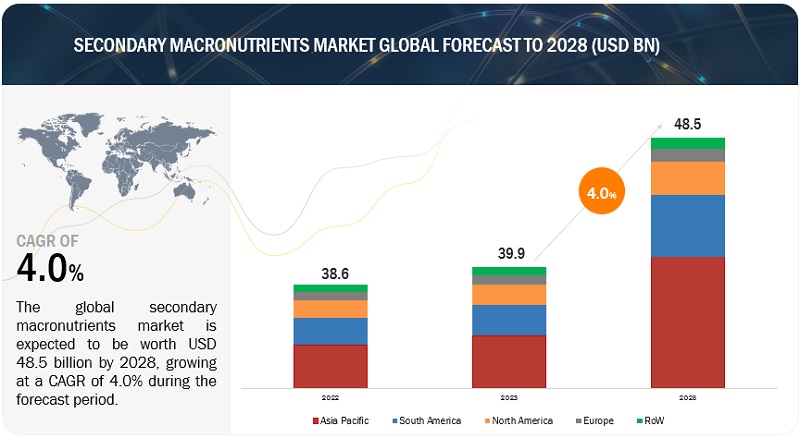The global secondary macronutrients market is gaining significant traction and is projected to witness notable growth over the coming years. Valued at USD 38.6 billion in 2022, the market is expected to reach USD 48.5 billion by 2028, growing at a CAGR of 4.0% from 2023 to 2028. This growth is largely driven by rising food demand—especially for cereals, grains, fruits, and vegetables—alongside a shift in agricultural practices focused on improving crop yield and quality.

Why the Market is Growing?
One of the major driving forces behind the market’s growth is the increasing awareness among farmers regarding the importance of secondary macronutrients—namely calcium, magnesium, and sulfur—in enhancing soil fertility and plant health. With global food security under pressure due to population growth and climate challenges, these nutrients are being recognized as essential for boosting crop productivity and quality.
Download PDF Brochure: https://www.marketsandmarkets.com/pdfdownloadNew.asp?id=45874881
Calcium: The Fastest Growing Nutrient Segment
Calcium stands out as the fastest-growing nutrient within the secondary macronutrients market. Often underestimated, calcium plays a crucial role in plant development. It improves root growth, flower and seed formation, and resistance to pests and diseases.
Calcium’s impact is particularly significant in high-demand crops such as:
- Sugarcane
- Rice
- Fruits
- Vegetables
Its ability to enhance overall plant resilience and improve reproductive structure development makes calcium a vital component in modern agricultural practices.
Fruits & Vegetables: Leading the Demand Surge
Among the crop types, fruits and vegetables are projected to be the fastest-growing segment during the forecast period. This trend aligns with:
- A global shift toward plant-based diets driven by veganism and vegetarianism
- Increased health consciousness among consumers
- Government and health organizations are advocating for greater fruit and vegetable consumption
The reliance of these crops on a balanced nutrient supply makes secondary macronutrients indispensable in their cultivation.
Liquid Form: A Flexible and Efficient Delivery Method
The liquid form of secondary macronutrients is emerging as the fastest-growing application format. Liquid fertilizers offer advantages such as:
- Easy application through foliar sprays, fertigation, or soil drenches
- Better nutrient distribution across the field
- Faster plant absorption and consistent crop growth
Farmers appreciate the flexibility and efficiency that liquid formulations bring, especially in large-scale or precision farming operations.
Request Sample Pages: https://www.marketsandmarkets.com/requestsampleNew.asp?id=45874881
South America: The Fastest-Growing Regional Market
South America is expected to witness the highest growth rate in the secondary macronutrients market. Key reasons include:
- A strong agricultural economy with high export potential
- Increasing availability and accessibility of nutrient fertilizers
- Government initiatives and farmer awareness programs promoting nutrient management
- Focus on improving crop quality to meet export standards
Countries like Brazil and Argentina are driving the regional surge due to their expansive farming landscapes and investment in modern agriculture.
Key Market Players
Several industry leaders are playing a vital role in shaping the secondary macronutrients market through innovation, distribution, and farmer engagement. Major companies include:
- Nutrien Ltd. (Canada)
- Yara (Norway)
- The Mosaic Company (US)
- Israel Chemicals Ltd. (Israel)
- K+S Aktiengesellschaft (Germany)
- IFFCO (India)
- Deepak Fertilisers and Petrochemicals Corporation Ltd. (India)
- Coromandel International Ltd (India)
- Koch Industries, Inc. (US)
- Nufarm (Australia)
These players are focusing on product development, regional expansion, and partnerships to cater to the evolving needs of global agriculture.
